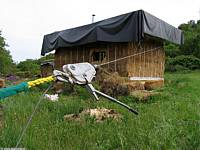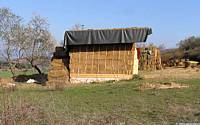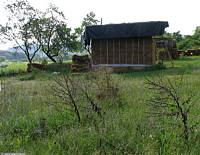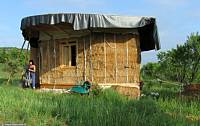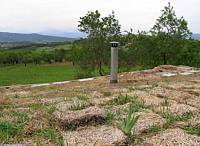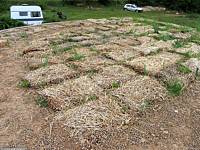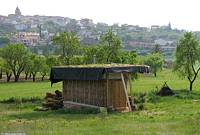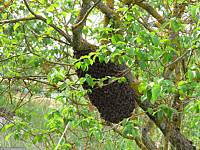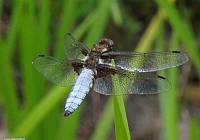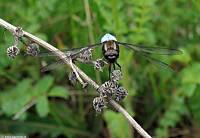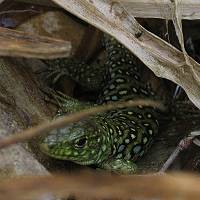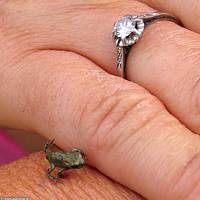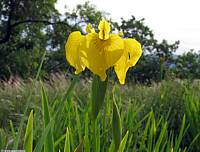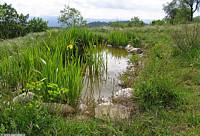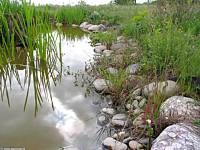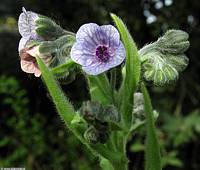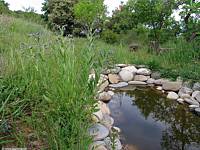|
|
Nature
Switched On
|
|
|
introduction |
2009 May 9 & 10, Saturday & Sunday
A
moving weekend: the idea (from my carpentry 'teacher') was to move
the strawbale walls to their
original vertical position
with the help of a lever operated hoist (a second hand |
The lever operated hoist with a yellow cable (from the car)
connected to an almond tree and an 8mm steel cable going round the
house. |
|
The operation was a bigger success than we dared to
expect. After a first session on Saturday, the north-west wall stood
almost completely vertical. We waited for Sunday for a second
session to give the bales time to settle and not overcharge the
hoist. On Sunday,
|
||
| Situation
before the operation. North-western wall. Photograph taken on 22 March 16:52 |
||
| After the
operation. Watch the vertical chimney pipe for reference. Sunday 10:56 |
South eastern part of the house, with the cables in position. |
|
|
The roof must have moved almost exclusively along the horizontal
plane during the operation because the chimney stayed miraculously
vertical. But it is not impossible that this will change when the
bales of the northern wall compress more during the coming
The vegetation of the roof is growing nicely. The Sedum species are thriving and so do the less desired barley seedlings of the bale flakes. These flakes perform two important functions during the initial stage of the green roof: maintaining humidity in the thin soil layer (of 6 cm) and avoiding erosion by heavy rain storms. I suppose I will take the straw away after the summer. |
Chimney with the load of stones in the eastern corner of the green roof. On the foreground a plant of Iris germanica which I am not sure of to maintain. Saturday 19:13 |
|
|
After the operation. |
Green roof with Sedum
species and barley in the spaces between the straw flakes. Looking west. Saturday 19:12 |
|
|
Some unexpected visitors this weekend. Ten thousands of them,
scaring the hell out of Blanca when she was sunbathing and saw a bl |
||
|
The swarm of bees settled in a Dogwood shrub. Saturday 17:03 |
||
|
The pond was again the scene of the
endless rivalry of two or three Broad-bodied Chasers (Libellula depressa).
We even witnessed the in-flight copulation of a male and a
golden-coloured female. An agitated spectacle which I was unable to
photograph.
After some years of wondering about the fate of so many tadpoles of the Natterjacks (Epidalea calamita ), we finally detected a tiny little toad on the pond shore. |
||
|
Male Libellula
depressa. Sunday 14:28 |
||
|
Young Ocellated Lizard hiding on the shore of the superior
pond. |
Libellula depressa
on an old stem of Picris hieracioides. Sunday 13:55 |
|
|
Tiny Epidalea calamita,
showing already its running abilities in Blanca's hand. (They don't
jump). Sunday 14:04 |
||
|
Of the plants, the flowers of the Yellow flag (Iris
pseudacorus) are stealing the show in the ponds.
|
||
|
The upper pond with about ten flowering Iris
pseudacorus. Looking south-east. Sunday 10:12 |
Close-up of Iris
pseudacorus. Saturday 8:36 |
|
|
The black EPDM liner on the right has become almost
invisible but is still avoiding the suction of pond water by the
surrounding soil. Sunday 10:07 |
||
|
In the lower pond plant life concentrates on the border just behind the EPDM liner, thereby also effectively hiding this ugly black sheet from view. Cynoglossum creticum has formed an impressive plant there. |
||
|
Cynoglossum creticum on the left in the lower
pond. Looking north-west. Saturday 9:08 |
Close-up of Cynoglossum
creticum flowers with the typical shift from red to blue of
the flowers. Saturday 9:10 |
|
|
introduction
|
|
